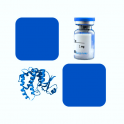
- Remove this product from my favorite's list.
- Add this product to my list of favorites.
Products
Newsletter
 |  |  |  |  |  |

Background
Cluster of Differentiation 74 (CD74) is also known as HLA class II histocompatibility antigen gamma chain (HLADG), DHLAG, Ia-GAMMA, invariant chain (Abbreviated Ii). CD74 / HLADG is a polypeptide involved in the formation and transport of MHC class II protein. The cell surface form of the invariant chain is known as CD74. CD74 is upregulated in several cancers and is also expressed by non-immune cells during inflammation. CD74 plays a critical role in MHC class II antigen processing by stabilizing peptide-free class II alpha / beta heterodimers in a complex soon after their synthesis and directing transport of the complex from the endoplasmic reticulum to the endosomal / lysosomal system where the antigen processing and binding of antigenic peptides to MHC class II takes place. CD74 / DHLAG also serves as cell surface receptor for the cytokine MIF.
Source
Recombinant Human CD74, His Tag (CD4-H524c) is expressed from human 293 cells (HEK293). It contains AA Gln 73 - Met 232 (Accession # NP_004346.1).
Predicted N-terminus: His
Molecular Characterization
This protein carries a polyhistidine tag at the N-terminus.
The protein has a calculated MW of 19.3 kDa. The protein migrates as 30-35 kDa under reducing (R) condition (SDS-PAGE) due to glycosylation.
Endotoxin
Less than 1.0 EU per μg by the LAL method.
Purity
>95% as determined by SDS-PAGE.
Formulation
Lyophilized from 0.22 μm filtered solution in PBS, pH7.4. Normally trehalose is added as protectant before lyophilization.
Reconstitution
See Certificate of Analysis for details of reconstitution instruction and specific concentration.
Storage
For long term storage, the product should be stored at lyophilized state at -20°C or lower.
Please avoid repeated freeze-thaw cycles.
This product is stable after storage at:
-20°C to -70°C for 12 months in lyophilized state;
-70°C for 3 months under sterile conditions after reconstitution.
(1) "Mapping Immune Correlates and Surfaceome Genes in BRAF Mutated Colorectal Cancers"
Morafraile, Saiz-Ladera, Nieto-Jiménez et al
Curr Oncol (2023) 30 (3), 2569-2581
(2) "Predictive value of CXCL10 for the occurrence of immune-related adverse events in patient with renal cell carcinoma"
Miura, Motoshima, Anami et al
Microbiol Immunol (2023)
(3) "An in silico approach to the identification of diagnostic and prognostic markers in low-grade gliomas"
Özbek, Toy, Oktay et al
PeerJ (2023) 11, e15096
Showing 1-3 of 1116 papers.
Follow us